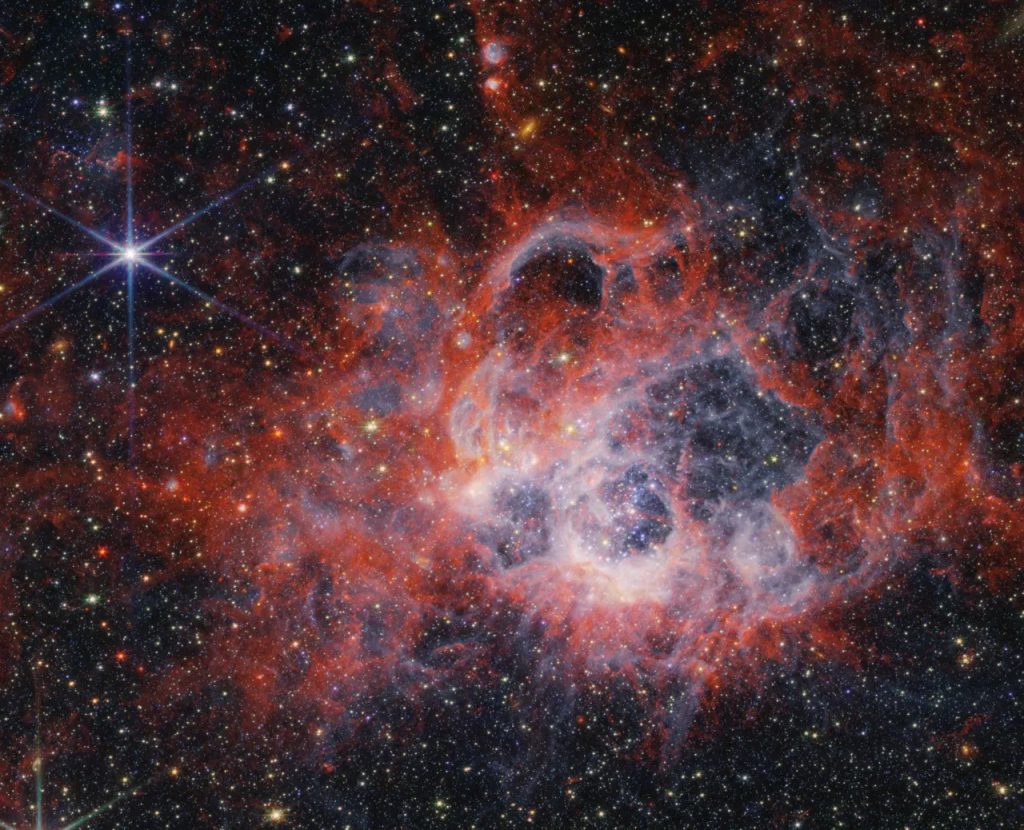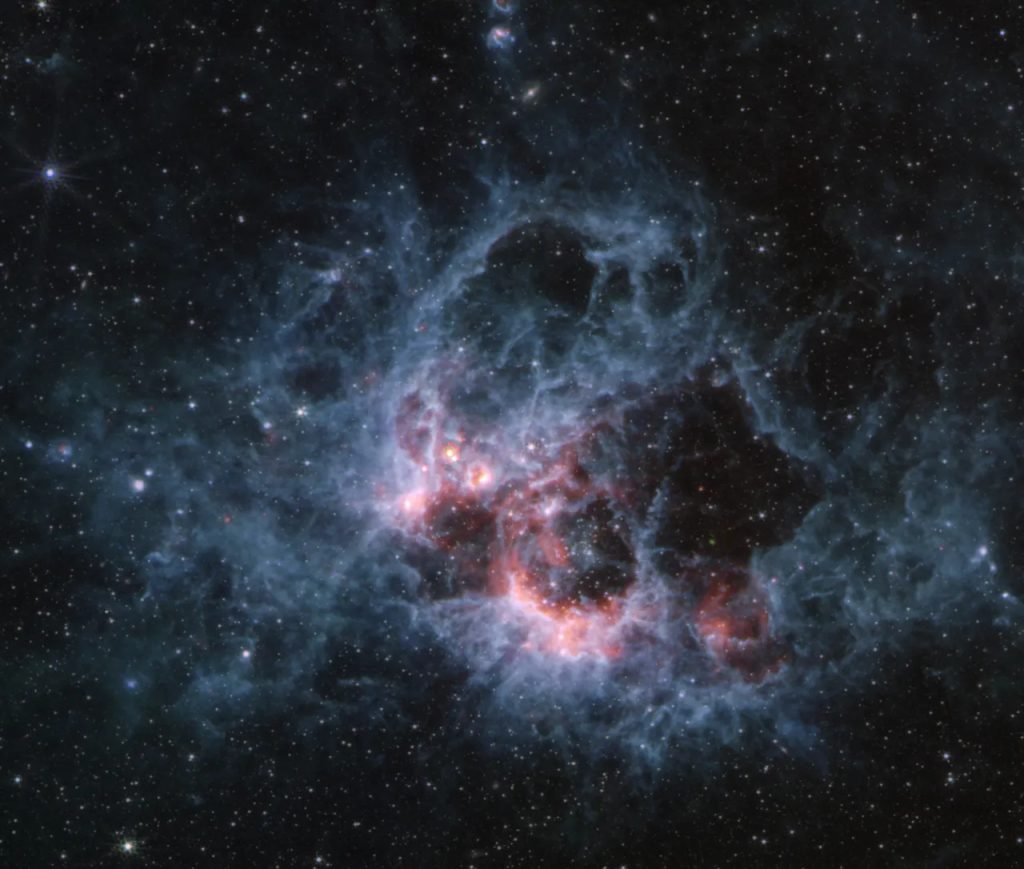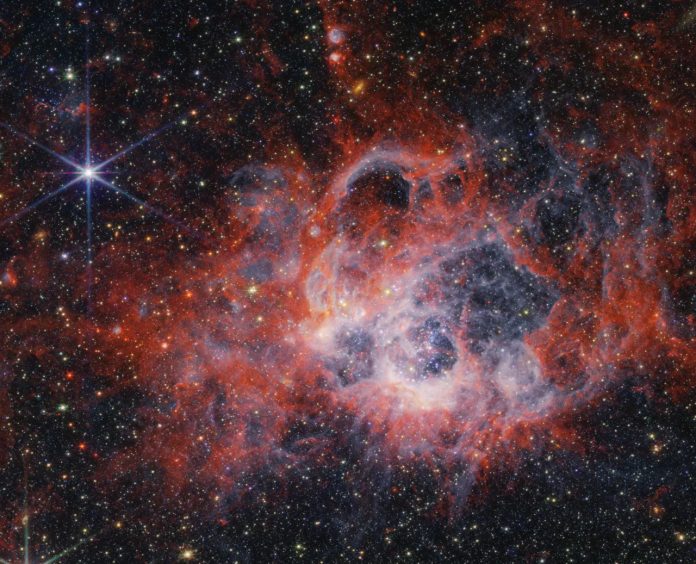James Webb geimsjónauki (JWST) has taken near-infrared and mid-infrared images of the star-forming region NGC 604, located nearby in the neighbourhood of home Galaxy. The images are most detailed ever and offer unique opportunity to study high concentration of massive, young stars in neighbouring galaxies to our home Galaxy, the Milky Way.
The high concentration of massive stjörnur at relatively close distance, means the star-forming NGC 604 offers a unique opportunity to study stars early in their life. Sometimes, the ability to study nearby objects (such as star-forming region NGC 604) at an extremely high resolution can help better understand more distant objects.
Nálægt innrauð sýn:
This image of NGC 604 is taken by NIRCam (Near-Infrared Camera) of JWST.
Tendrils and clumps of emission that appear bright red, extending out from areas that look like clearings, or large bubbles in the nebula are the most noticeable features of the near-infrared image. Stellar winds from the brightest and hottest young stjörnur have carved out these cavities, while ultraviolet radiation ionizes the surrounding gas. This ionized hydrogen appears as a white and blue ghostly glow.

The bright, orange-coloured streaks signify the presence of carbon-based molecules known as polycyclic aromatic hydrocarbons, or PAHs. This material plays an important role in the interstellar medium and the formation of stars and plánetur, but its origin is a mystery.
The deeper red signifies molecular hydrogen as one travel farther from the immediate clearings of dust. This cooler gas is a prime environment for stjörnu myndun.
The exquisite resolution also provides insights into features that previously appeared unrelated to the main cloud. For example, in Webb’s image, there are two bright, young stars carving out holes in dust above the central nebula, connected through diffuse red gas. In visible-light imaging from Hubble Space Telescope (HST), these appeared as separate splotches.
Mið-innrauð sýn:
This image of NGC 604 is by MIRI (Mid-Infrared Instrument) of JWST.
Það eru áberandi færri stjörnur í miðju innrauða útsýninu vegna þess að heitar stjörnur gefa frá sér mun minna ljós á þessum bylgjulengdum á meðan stærri skýin af kaldara gasi og ryki glóa.

Some of the stars seen in this image, belonging to the surrounding Galaxy, are red supergiants – stars that are cool but very large, hundreds of times the diameter of our Sun. Additionally, some of the background galaxies that appeared in the NIRCam image also fade.
Á MIRI myndinni tákna bláu tendrs efnisins tilvist PAH.
Mið-innrauða útsýnið sýnir einnig nýtt sjónarhorn á fjölbreytta og kraftmikla starfsemi þessa svæðis.
Stjörnumyndunarsvæðið NGC 604
The star-forming region NGC 604 is estimated to be around 3.5 million years old. The cloud of glowing gases extends to some 1,300 light-years across. Located 2.73 million light-years away in the nearby Triangulum Galaxy, this region is large in extent and contains many more recently formed stars. Such regions are small-scale versions of more distant “starburst” galaxies, which underwent an extremely high rate of star formation.
Í rykugum gashjúpunum eru meira en 200 heitustu, massamestu tegundir stjarna, allar á fyrstu stigum lífs síns. Þessar tegundir stjarna eru B-gerðir og O-gerðir, en sú síðarnefnda getur verið meira en 100 sinnum massameiri en okkar eigin sól.
Það er frekar sjaldgæft að finna þennan styrk af þeim í nágrenninu alheimurinn. In fact, there’s no similar region within our own Milky Way Galaxy.
Þessi styrkur massamikilla stjarna ásamt tiltölulega stuttri fjarlægð þýðir að NGC 604 gefur stjörnufræðingum tækifæri til að rannsaka þessi fyrirbæri á heillandi tíma snemma á lífsleiðinni. Stundum getur hæfileikinn til að rannsaka nálæg fyrirbæri eins og stjörnumyndunarsvæði NGC 604 í mjög mikilli upplausn hjálpað til við að skilja fjarlægari fyrirbæri betur.
***
Tilvísanir:
Space Telescope Science Institute (STScI) 2024. Fréttatilkynning – Skyggnst inn í tendrils NGC 604 með Webb frá NASA. 09. mars 2024. Laus kl https://webbtelescope.org/contents/news-releases/2024/news-2024-110.html
***






































